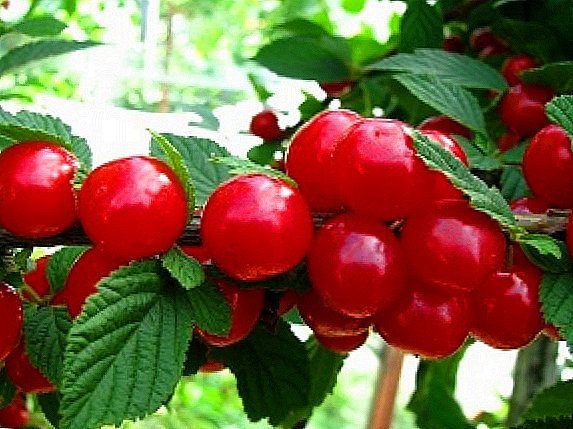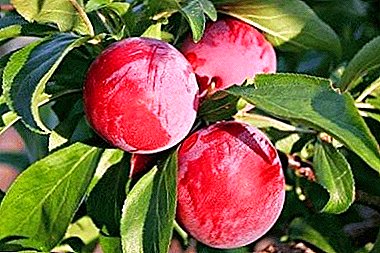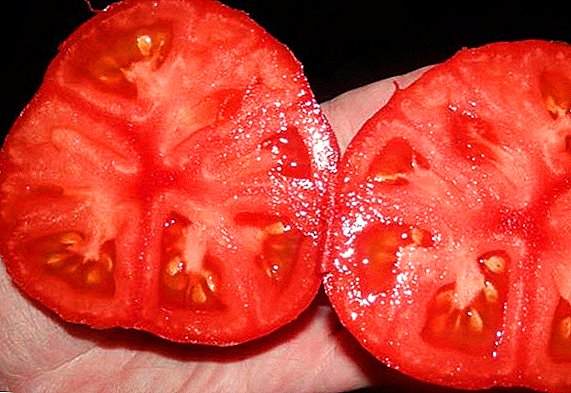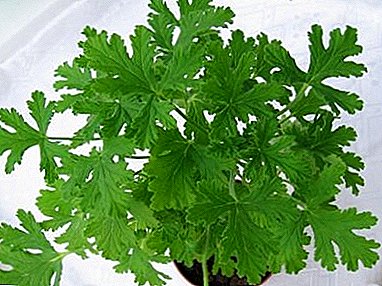
Table grade Victoria has long been very popular among gardeners. His bushes with spectacular large clusters can be found even in the Moscow region.
And this is not by chance, because "Victoria" has a lot of advantages - it is hardy, high-yielding and extremely tasty.
However, in order to grow an excellent crop of fragrant raspberry-red berries, it is important to take into account all the characteristics of this wonderful variety and the requirements that it makes.
Description varieties Victoria
Table grapes "Victoria" - is an old and well-known variety, bred by Russian breeders. Due to its frost resistance, taste and disease resistance, it is very popular among wine growers. Also Korinka Russian, Friendship and Kuban is grown for fresh consumption and canning.
Some sources sometimes mention the Uehara variety, called the Victoria clone, which is a mistake. Clone selection "Victoria" was not carried out.
"Uehara" is the first working title of the variety. When the future "Victoria" was first obtained, in appearance it resembled varieties of Japanese selection, bred at Uehara station, and therefore acquired such a temporary name.
 When buying planting material you need to find out the exact name of the variety.
When buying planting material you need to find out the exact name of the variety.
In addition to "Victoria" of Russian origin, there are varieties with similar names as "Victoria Gönge" (Hungarian wine variety) and "Victoria" of the Romanian selection - white table variety.
Also, there is a hybrid dining form from Ukraine with the working title "Victoria White".
Appearance of grapes
Shrubs have a weak or moderate growth. Vine covered with dark green leaves of medium size, medium dissected, five-lobed and covered with light pubescence.
"Victoria" - a variety with beautiful and massive clusters, reaching up to 700 g of weight.
They have a conical, moderately dense, and sometimes loose shape. Large oval-ovoid berries weighing up to 7.5 g and length up to 2.7 cm each are colored crimson red, but shades may vary depending on the pollinator variety lying next to it. The surface of the fruit is slightly covered with pollen.
Such varieties as Taifi, Chocolate and Sophia differ in special beauty.
The fleshy, crunchy and juicy fruits of "Victoria" have a pleasant harmonious taste. At the peak of maturity, the berries acquire a noble muscat flavor. The acidity of the fruit is not more than 6 g / l, and the sugar content is about 19%.
Breeding history
Victoria grapes were bred by the breeders of the city of Novocherkassk in the VNIIViV named after Ya.I. Potapenko. This is the result of crossing a frost-resistant variety called "Save Vilar 12-304" with a hardy Euro-Amur hybrid obtained from "Vitis Amurenzis" and "Vitis Winifer". From its parents, "Victoria" took over all the best qualities: frost resistance, precociousness and resistance to diseases.
In the same scientific research institute the Delight of Ideal, Platovsky and Amethyst were born.
The resulting variety is very fond of growers. Due to its qualities, it is successfully grown in the southern regions of Russia, in Siberia, in the middle lane and even in the Moscow region.
A photo




Specifications
 "Victoria" refers to varieties of early ripening. From blooming buds to full maturity of the fruits, it takes from 115 to 120 days. In the middle lane, the fruits ripen by the end of August, and in the Siberian regions - in early September. The variety is skoroplodny. The first harvest can be taken on the 2nd or 3rd year of life, "Victoria."
"Victoria" refers to varieties of early ripening. From blooming buds to full maturity of the fruits, it takes from 115 to 120 days. In the middle lane, the fruits ripen by the end of August, and in the Siberian regions - in early September. The variety is skoroplodny. The first harvest can be taken on the 2nd or 3rd year of life, "Victoria."
The ayut of Pavlovsky, Present Nesvetaya and Amirkhan are distinguished by the same sign.
Productivity varieties high with excellent maturation of the shoots.
The vine is densely fruiting, releasing up to 80-90% of fruitful shoots, which leads to crop overload and, as a result, shallow (pea) berries and non-ripening.
Therefore, "Victoria" needs to rationing the number of inflorescences and clusters forming with the help of pruning.
On one shoot should be on average no more than 1.8 clusters. At the same time, one should avoid thickening and take into account that the optimal load on one bush of "Victoria" is from 25 to 30 holes with a long pruning of fruit shoots, when there are 5 or 8 holes on each shoot.
You can leave on the shoot 2 or 3 peepholes, since at the very base of the shoot they have high fruitfulness.
Excellent yields are shown in the memory of Dombkowska, Alex and Podarok Magaracha.
"Victoria", grown on a strong-growing stock, brings even larger berries. It responds to timely watering and root top dressing in the form of nitrogen-potassium fertilizers, wood ash and organic matter by a significant increase in yield.
The variety is prone to pea, that is, fruiting with small berries. This problem can be easily solved. During the period of fruit growth, each bunch is taken in hand and combed with a paint brush. At the same time dried flowers and small berries are removed.
The cluster for some time becomes loose and sparse, but on the other hand there is enough space on it to ripen future large berries. Thanks to this procedure, after a while the bunch is filled with fragrant selected fruits.
Another distinctive feature of the variety is the functional female type of flowers. For high yields, "Victoria" requires pollinator varieties that begin to bloom along with it, such as Neptune, Kishmish Radiant, Augustine, Platovsky, Bianka, Agat Donskoy, and Crystal.
The grade is remarkable high frost resistance. Grapevine "Victoria" is able to withstand temperatures down to -27 ° C. In the Volgograd region, the variety bears fruit very well in places protected by buildings and trees, without winter insulation. In the middle latitudes, grapes require light shelter for the winter.
Diseases and pests
 The grape variety "Victoria" is highly resistant to gray rot, mildew (from 2.5 to 3 points), oidium (3 points) and such a dangerous pest as a threatening moth.
The grape variety "Victoria" is highly resistant to gray rot, mildew (from 2.5 to 3 points), oidium (3 points) and such a dangerous pest as a threatening moth.
In the rainy season, the berries are prone to cracking. This problem can be solved by providing good airing and illumination to the bushes, as well as timely feeding.
However, it should be remembered that Victoria does not like growth stimulants very much, and it’s best to completely abandon them. When a small area of the vineyard from excessive moisture during prolonged rains can save awning canopy.
The sweet, thin-skinned berries of "Victoria" are very indifferent wasps.
In the period of ripening berries is a real disaster for grapes. Wasps, if not fought with them, are able to destroy the entire crop.
Effectively protect the grapes from pests, sweet teeth, special traps. Around the vineyard are placed banks with honey or sugar solution, in which you can add chlorophos (0.5%) or any insecticide.
In addition, you should regularly find wasp nests and destroy them. Experienced winegrowers cover ripening clusters with special mesh bags.blocking the path to fragrant berries. Well scare wasps planted under the grape bush spicy herbs.
In dry and hot weather, a grape mite can attack Victoria. The presence of the pest can be determined by the tubercular swellings on the leaves. As a result, their damage disturbed photosynthesis and further development of the bush.
Ripening clusters of berries are not subject to special changes. Measures to combat grape mites - processing bushes "Konfidor", "BI-58", "Neoron" or colloidal sulfur, but no later than three weeks before the berries are picked.
Wonderful grapes "Victoria", like any culture, requires labor, diligence and patience. By providing the variety with the necessary conditions and protecting it from the invasion of wasps, it is possible to grow an excellent crop of berries with a wonderful nutmeg aroma. Variety "Victoria" is worthy to remain a darling of winegrowers for many years.












